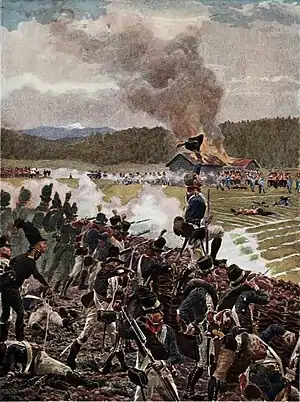Battle of Mobekk
The Battle of Mobekk was fought on 18 May 1808, between Swedish and Norwegian forces, during the Swedish invasion of Norway. After the Swedish victory at Lier, Bernhard Ditlef von Staffeldt ordered Johan Georg Ræder to attack the right flank of Gustaf Mauritz Armfelt, along the Skinnarbøl river. The Norwegians managed to force a few Swedish positions across the river, but met fierce resistance at the Swedish redoubt at Mobekk; Ræder conducted three storming attempts, each of them being repulsed, before retreating with his force, after five hours of fighting. The battle had no strategic effect, as Armfelt retreated out of Norway in May and June, after misinterpreting the orders from the Swedish king, Gustav IV Adolf, which advocated for him to act defensively.
| Battle of Mobekk | |||||||
|---|---|---|---|---|---|---|---|
| Part of the Dano-Swedish War of 1808–09 | |||||||
 Battle of Mobekk, by Andreas Bloch | |||||||
| |||||||
| Belligerents | |||||||
|
|
| ||||||
| Commanders and leaders | |||||||
|
|
| ||||||
| Strength | |||||||
| 300[1] | 800[1] | ||||||
| Casualties and losses | |||||||
| 38[2] | 40–269[2][3] | ||||||
Background
After the Swedish victory at Lier, Gustaf Mauritz Armfelt remained with the first Swedish brigade around Lier,[4] awaiting the spring to break up the ice at the Glomma, before resuming the offensive towards the fortress of Kongsvinger.[5] Several Swedish detachments were sent from other brigades, to reinforce his position. A few minor skirmishes occurred in the vicinity, notably around Masterud, without significant results.[6][7] In mid-May, the Norwegian commander, Christian August, ordered Bernhard Ditlef von Staffeldt to conduct a counterattack against the Swedish outposts at the Skinnarbøl river (between the Vinger and Digeren lakes), on Armfelt's right flank.[8][9] Staffeldt ordered Johan Georg Ræder to march with 800 men, in three columns, against the Swedish outposts along the river which consisted of about 300 men, under Carl Cederström. The Swedes had several entrenchments north of the river, some of them unfinished, most notably the one at Mobekk.[1]
Battle
The left Norwegian column, personally led by Ræder, attacked Mobekk at 11:30; it was guarded by 90 men out of the Hälsinge and Närke-Värmland regiments, under captain Ström. Subsequently, the remaining columns also attacked the nearby Swedish positions at Skansgarden and Skinnarbøl, of which both received orders to withdraw south, across the river; the Swedes burnt the bridge behind them, denying every attempt made by the Norwegians to ford the river. After a while, the Norwegians instead sent additional reinforcements towards Mobekk, where intense fighting took place. At 12:00, the Swedes at Mobekk, likewise, received reinforcements, consisting of 40 men from the Värmland Jägers, under captain Lagerlöf, who seized command over the troops—in total, about 130 Swedes would stand against 450 Norwegians.[10]
Some Norwegian sharpshooters climbed up on the nearby houses, to lay down accurate fire into the redoubt.[11] Meanwhile, the Norwegians stormed three times, while a contingent also attempted to sweep around, to ford the river in the back of the Swedes; Lagerlöf counter-attacked and threw them back, while the Norwegian attacks against the redoubt were simultaneously repulsed.[10] A Swedish sergeant, named Diricker, distinguished himself as he climbed up the defenses, each time the Norwegians stormed, and swung his hat around while greeting them 'welcome!', inspiring his comrades to fight harder.[11] At 16:45, the Norwegians retreated, as Ræder was unable to rally his forces to mount another attack. Lagerlöf's Jägers pursued for more than one kilometre, and the Swedes retook their previous positions.[2]
Aftermath
The Norwegians admitted a loss of 7 men killed, 27 wounded and 6 captured,[2] which, in regards to the intensity of the fighting—which had resulted in three failed storming attempts—may be considered as too low.[12] The Swedes estimated higher Norwegian losses; one report mentions as many as 269 (including 16 captured).[3] The Swedes, who fought the majority of the battle behind entrenchments, had suffered 5 men killed and 33 wounded (including one contusion). After the battle, Staffeldt sent a letter to Christian August in which he explicated the lack of capable officers, as well as trained privates, as a reason for the defeat,[2] although complimenting their bravery.[13] In retaliation for his defeat, Staffeldt attacked a small Swedish outpost of 29 men at Jerpset, with 150 men, in the night of 24–25 May, capturing or killing the Swedish force.[14]
Meanwhile, on 24 May, Armfelt received orders from the Swedish king, Gustav IV Adolf, to fall back to a more advantageous position; the king planned to land an Anglo-Swedish force at Zealand, to attack Denmark, while Armfelt would act defensively. Armfelt, however, misinterpreted the order,[15] and began an all-out retreat out of Norway, on 29 May. By mid-June the Swedes had completely abandoned Norway, with the exception of a small force at Prestebakke and berby;[16] These were forced to surrender, after being surprised at Prestebakke by an overwhelming Norwegian force, on 10 June.[17]
Citations and sources
Citations
- Generalstaben 1915, pp. 306–307.
- Generalstaben 1915, p. 309.
- Prytz 1867, p. 509.
- Generalstaben 1915, p. 301.
- Generalstaben 1915, pp. 240–241.
- Generalstaben 1915, pp. 301–302.
- Angell 1914, p. 121.
- Generalstaben 1915, p. 305.
- Angell 1914, p. 122.
- Generalstaben 1915, pp. 307–308.
- Angell 1914, p. 124.
- Meijer 1867, p. 105.
- Angell 1914, pp. 124–125.
- Generalstaben 1915, pp. 309–311.
- Generalstaben 1915, pp. 349–354.
- Generalstaben 1915, pp. 354–359.
- Generalstaben 1915, pp. 365–385.
Sources
- Generalstaben (1915). Sveriges krig åren 1808 och 1809, Volume 6 (in Swedish). Stockholm: Kongl. boktryckeriet P. A. Norstedt & söner.
- Angell, Henrik (1914). Syv-Aars-Krigen for 17. Mai 1807–1814 (in Norwegian). Kristiania: H. Aschehoug & Co.
- Meijer, Carl Fredrik (1867). Kriget emellan Sverige och Danmark, åren 1808 och 1809 (in Swedish). Stockholm: Oscar L. Lamms Förlag.
- Prytz, Harold Oscar (1867). Historiska upplysningar om Svenska och Norska arméernas regementer och kårer jemte flottorna under ledning (in Swedish). Stockholm: P. B. Eklund.